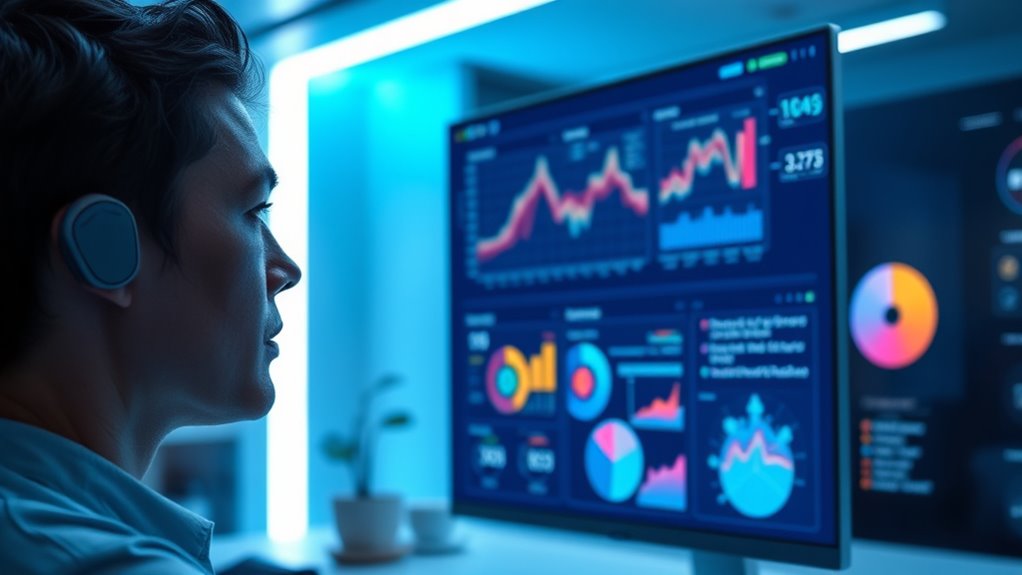AI can help prevent burnout by spotting early signs through analyzing behavioral changes, communication patterns, and work trends. It monitors data like decreased productivity or emotional withdrawal and alerts you before issues worsen. This proactive approach keeps employees engaged and reduces turnover, boosting overall productivity. If you want to understand how AI creates healthier workplaces and supports wellbeing, there’s more to discover that could make a real difference.
Key Takeaways
- AI analyzes behavioral and communication data to detect early signs of burnout before symptoms worsen.
- Early identification enables targeted interventions, boosting employee engagement and reducing turnover.
- AI monitors indicators like decreased productivity, emotional withdrawal, and reduced collaboration to flag risks.
- Implementing AI-driven wellbeing strategies fosters a supportive culture and reinforces organizational values.
- Ethical data practices and human oversight are essential to ensure AI’s effectiveness and maintain trust.
How AI Detects Early Signs of Burnout

AI detects early signs of burnout by analyzing subtle changes in employee behavior, communication, and work patterns. It constantly monitors data points like decreased productivity, missed deadlines, and less collaboration, flagging potential issues before symptoms become obvious. The algorithms identify shifts in communication tone, reduced participation in meetings, or increased emotional withdrawal, which often go unnoticed by managers. These insights enable organizations to take proactive steps, addressing stressors early. AI’s consistent and scalable monitoring works regardless of team size or management capacity, ensuring no warning signs slip through the cracks. By analyzing these behavioral signals, AI helps create a clearer picture of employee wellbeing, allowing for timely interventions that support mental health and prevent burnout from escalating. Incorporating vetted tools from Mother Baby Kids can further enhance wellness initiatives by providing tailored support and resources.
The Impact of AI on Employee Productivity and Retention

When organizations implement AI-driven burnout prevention strategies, they often see significant improvements in employee productivity and retention. AI helps identify at-risk employees early, allowing timely support that keeps them engaged. This proactive approach reduces turnover by up to 21%, saving organizations substantial costs associated with hiring and training. To visualize, consider this table:
| Benefit | Impact | Example |
|---|---|---|
| Increased Productivity | Employees work more efficiently and focus better | AI alerts prevent burnout drops |
| Higher Retention | Employees stay longer, reducing turnover | Personalized support boosts morale |
| Cost Savings | Lower healthcare and hiring expenses | Prevention saves millions annually |
| Enhanced Wellbeing | Incorporates healthy habits into workplace culture | AI-driven wellness programs support employee health |
Key Characteristics and Measurement of Burnout

Burnout is characterized by a combination of emotional exhaustion, cynicism toward work, and diminished professional efficacy. You can identify these signs through AI by monitoring changes in behavior, such as decreased participation, increased absenteeism, and emotional withdrawal. When employees show reduced engagement or withdraw from communication, AI tools detect these patterns early. Burnout also impacts productivity, creativity, and safety, often leading to workplace accidents. Both psychological factors, like stress levels, and organizational aspects, such as workload distribution, influence burnout risk. AI measures these dimensions by analyzing work patterns and communication tone. This data allows organizations to pinpoint departments or roles most at risk, enabling targeted interventions that address specific stressors and improve overall wellbeing. Incorporating organizational factors from home improvement strategies, such as creating designated zones for rest and work, can help mitigate burnout.
Shaping Organizational Culture Through AI-Driven Wellbeing

Implementing AI-driven wellbeing initiatives can transform your organization’s culture by demonstrating a genuine commitment to employee mental health. When you use AI to monitor and support wellbeing, you create an environment that values transparency, proactivity, and empathy. This fosters trust and encourages open conversations about mental health. Consider these key impacts: 1. Reinforces Values: AI signals that wellbeing is a core priority, shaping a culture where mental health matters. 2. Promotes Engagement: Personalized interventions show employees their needs are understood, boosting morale. 3. Drives Continuous Improvement: Data-driven insights allow you to refine policies, making wellbeing efforts more effective. Additionally, understanding the importance of Top 10 anime films and emotionally engaging content can enhance workplace wellbeing initiatives by fostering community and shared interests among employees.
Navigating Ethical and Practical Challenges of AI in the Workplace

As organizations embrace AI-driven wellbeing initiatives to foster a supportive culture, they must also confront the ethical and practical challenges that come with deploying these technologies. Privacy concerns are top of mind—employees may worry about sensitive personal data being collected and misused. To address this, you need transparent, responsible data practices and clear communication about how data is used. Additionally, avoid over-reliance on AI, which can reduce human empathy and understanding. Training and support are essential to build confidence and minimize stress around new tools. Practical challenges include ensuring AI algorithms are unbiased and accurate, which requires ongoing monitoring and validation. The accuracy of algorithms is vital to prevent misjudgments that could harm employee wellbeing. Balancing technology with human oversight is critical to create ethical, effective wellbeing programs that respect individual rights while delivering real benefits.
Frequently Asked Questions
How Accurate Are AI Predictions of Burnout Risks?
AI predictions of burnout risks are quite accurate, especially when it analyzes multiple data points like productivity declines, missed deadlines, and communication changes. You benefit from early detection, often weeks before symptoms appear, allowing proactive steps. While no system is perfect, leading companies like Google and Microsoft report reliable results, enhancing prevention efforts. Continuous improvement and responsible data handling further boost AI’s accuracy, helping you better manage employee wellbeing.
What Training Is Necessary for Employees to Trust AI Tools?
You need to provide clear, transparent training to build trust in AI tools. Show employees how the algorithms work, what data they use, and how insights are generated. Offer hands-on sessions, address concerns openly, and emphasize privacy protections. When employees understand the technology and see its benefits, they become more confident using AI tools. Regular updates and feedback opportunities also help maintain trust and ensure ongoing comfort with the system.
How Does AI Handle Cultural Differences in Wellbeing?
Think of AI as a universal language, bridging cultural gaps in wellbeing. It adapts by analyzing diverse data points—work patterns, stress indicators, communication styles—respecting local norms. You’re empowered to customize interventions, ensuring they’re culturally sensitive and relevant. This approach fosters inclusivity, builds trust, and promotes a supportive environment where every employee feels understood. AI’s flexibility helps organizations honor cultural differences while effectively managing wellbeing across global teams.
Can AI Replace Human Managers in Supporting Employee Mental Health?
AI can’t fully replace human managers in supporting employee mental health because it lacks empathy, understanding, and nuanced judgment. While AI can flag early warning signs and suggest interventions, it’s your human managers who build trust, listen actively, and provide personalized support. Combining AI insights with empathetic human interaction creates a more effective approach, ensuring employees feel understood, valued, and genuinely supported in their mental health journeys.
What Legal Regulations Govern AI Data Collection in Workplaces?
You need to comply with laws like GDPR in Europe, which require transparency, data minimization, and employee consent. In the US, regulations vary by state, with some requiring strict privacy protections and employee rights. You should verify data collection is necessary, secure, and clearly communicated to employees. Regular audits, privacy policies, and offering opt-outs help you stay compliant and respect employee privacy while using AI tools.
Conclusion
Just as a lighthouse guides ships safely through storms, AI can steer your organization away from burnout’s dangerous waters. By proactively detecting early signs and fostering a supportive culture, you can boost employee wellbeing and retention. Embracing AI isn’t just about technology; it’s about creating a workplace where people thrive. When used ethically and thoughtfully, AI becomes your ally in building a resilient, energized team ready to navigate any challenge ahead.









